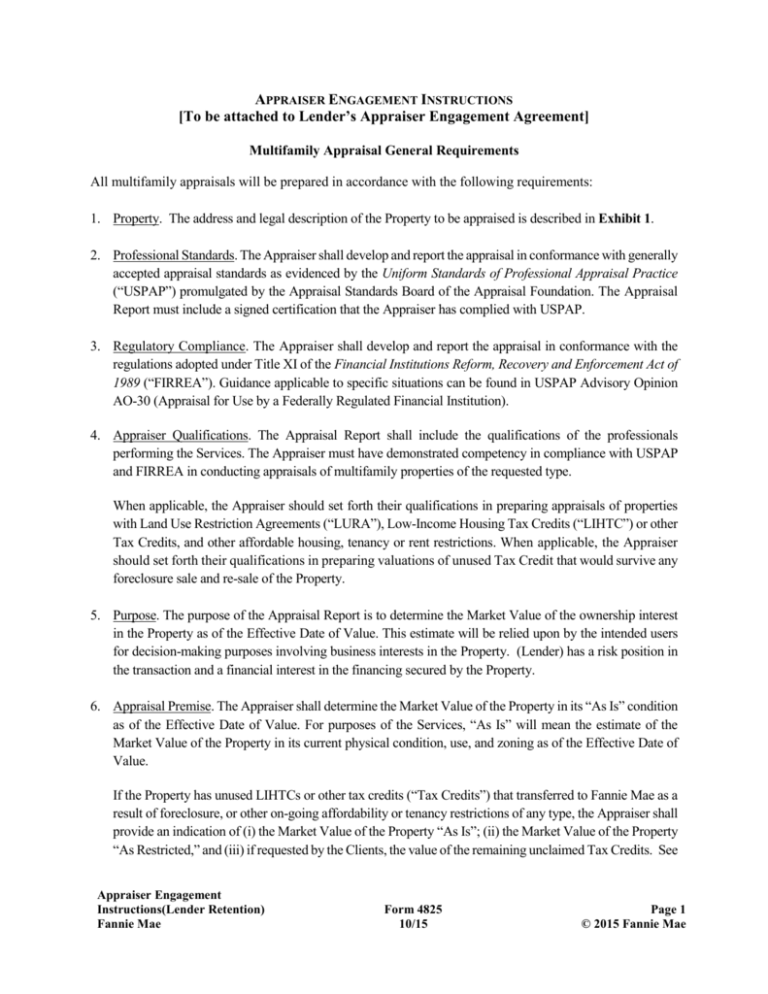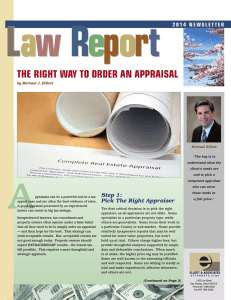Form 4825 - Fannie Mae
advertisement

APPRAISER ENGAGEMENT INSTRUCTIONS [To be attached to Lender’s Appraiser Engagement Agreement] Multifamily Appraisal General Requirements All multifamily appraisals will be prepared in accordance with the following requirements: 1. Property. The address and legal description of the Property to be appraised is described in Exhibit 1. 2. Professional Standards. The Appraiser shall develop and report the appraisal in conformance with generally accepted appraisal standards as evidenced by the Uniform Standards of Professional Appraisal Practice (“USPAP”) promulgated by the Appraisal Standards Board of the Appraisal Foundation. The Appraisal Report must include a signed certification that the Appraiser has complied with USPAP. 3. Regulatory Compliance. The Appraiser shall develop and report the appraisal in conformance with the regulations adopted under Title XI of the Financial Institutions Reform, Recovery and Enforcement Act of 1989 (“FIRREA”). Guidance applicable to specific situations can be found in USPAP Advisory Opinion AO-30 (Appraisal for Use by a Federally Regulated Financial Institution). 4. Appraiser Qualifications. The Appraisal Report shall include the qualifications of the professionals performing the Services. The Appraiser must have demonstrated competency in compliance with USPAP and FIRREA in conducting appraisals of multifamily properties of the requested type. When applicable, the Appraiser should set forth their qualifications in preparing appraisals of properties with Land Use Restriction Agreements (“LURA”), Low-Income Housing Tax Credits (“LIHTC”) or other Tax Credits, and other affordable housing, tenancy or rent restrictions. When applicable, the Appraiser should set forth their qualifications in preparing valuations of unused Tax Credit that would survive any foreclosure sale and re-sale of the Property. 5. Purpose. The purpose of the Appraisal Report is to determine the Market Value of the ownership interest in the Property as of the Effective Date of Value. This estimate will be relied upon by the intended users for decision-making purposes involving business interests in the Property. (Lender) has a risk position in the transaction and a financial interest in the financing secured by the Property. 6. Appraisal Premise. The Appraiser shall determine the Market Value of the Property in its “As Is” condition as of the Effective Date of Value. For purposes of the Services, “As Is” will mean the estimate of the Market Value of the Property in its current physical condition, use, and zoning as of the Effective Date of Value. If the Property has unused LIHTCs or other tax credits (“Tax Credits”) that transferred to Fannie Mae as a result of foreclosure, or other on-going affordability or tenancy restrictions of any type, the Appraiser shall provide an indication of (i) the Market Value of the Property “As Is”; (ii) the Market Value of the Property “As Restricted,” and (iii) if requested by the Clients, the value of the remaining unclaimed Tax Credits. See Appraiser Engagement Instructions(Lender Retention) Fannie Mae Form 4825 10/15 Page 1 © 2015 Fannie Mae Sections 15 – 21 below for additional information for Tax Credits and other affordability and tenancy restriction appraisal requirements. 7. Report Format. The report format should conform to USPAP requirements for an Appraisal Report. The Appraisal Report should contain all significant data to allow the reader to understand the scope of the work performed (self-contained). Include (Lender) as intended users. Discuss the physical inspection of the interior and exterior areas of the Property. Include photographs that represent the condition and quality of the Property. Discuss the market area (neighborhood) conditions and disclose the extent of market area inspections performed. Include and discuss a supportable and defensible highest and best use. Comparable properties should have a same or similar highest and best use as the Property. However, if identical properties are not available, the appraiser should make an adjustment for the differences. Include a discussion of how the capitalization rate is derived when a direct capitalization analysis is used. Discuss the analysis of each comparable sale and disclose the extent of any inspections performed. Include an adjustment grid with appraiser-applied adjustments, if any. Discuss the analysis of each comparable rental and disclose the extent of any inspections performed. Include an adjustment grid with appraiser-applied adjustments, if any. Discuss each of the lease absorption comparables, if any, and disclose the extent of inspections performed. Include maps to denote the location of the Property relative to the market area and the comparable properties. Note the appraisal professional's license or certification numbers and include a copy of the license or certification. Include a signed copy of the Engagement Letter and all Attachments. Include property information provided to the Appraiser during the assignment and the source (e.g., rent rolls, operating statements, budgets). 8. Scope of Work: In conformance with the USPAP Scope of Work Rule, the Appraisal Report must reflect an appropriate scope of work that provides for credible assignment results. The Appraiser is to conform with the previously noted professional standards and regulations and: If the Property contains commercial space, the Appraisal Report must segregate the commercial revenue, expenses and income attributable to that space from the residential operations attributable to the Property. The Appraisal Report’s commercial cash flow estimates must reflect any special conditions indicated in the commercial leases that would impact the net cash flows of the Property. Analyze and report the estimated length of the marketing period considered typical in the market and reflected in the market value as of the Effective Date of Value. 9. Non-stabilized Occupancy: The Appraiser shall analyze and report appropriate adjustments and discounts for partially leased buildings and non-stabilized assets. (See Appendix C, Deductions and Appraiser Engagement Instructions(Lender Retention) Fannie Mae Form 4825 10/15 Page 2 © 2015 Fannie Mae Discounts-Interagency Appraisal and Evaluation Guidelines published in December 2010). Additionally, if the Property’s occupancy is not stabilized as of the Effective Date of Value, the Appraiser shall include a lease-up analysis and discussion with a minimum of three supplemental comparable sales with less-than-stabilized occupancy, if such comparable sales are available. The Appraiser shall analyze, reconcile and discuss the final concluded Market Value of the Property with the unadjusted sale prices of the supplemental comparable sales regarding any differences in the properties’ characteristics, locations and/or the terms of sale. 10. Market Value: As defined by the Office of the Comptroller of Currency under 12 CFR, Part 34, Subpart C-Appraisals, 34.42 Definitions; the Board of Governors of the Federal Reserve System; the Federal Deposit Insurance Corporation; and in compliance with Title XI of FIRREA and the Interagency Appraisal and Evaluation Guidelines, as well as USPAP, and for purposes of the Services, market value is as defined follows: “the most probable price which a property should bring in a competitive and open market under all conditions requisite to a fair sale, the buyer and seller each acting prudently and knowledgeably, and assuming the price is not affected by undue stimulus. Implicit in this definition is the consummation of a sale as of a specified date and the passing of title from seller to buyer under conditions whereby: (a) Buyer and seller are typically motivated; (b) Both parties are well informed or well advised, and acting in what they consider their own best interests; (c) A reasonable time is allowed for exposure in the open market; (d) Payment is made in terms of cash in U.S. dollars or in terms of financial arrangements comparable thereto; and (e) The price represents the normal consideration for the property sold unaffected by special or creative financing or sales concessions granted by anyone associated with the sale.” 11. 12. Ownership Interest in the Property is identified in Exhibit1. The acceptable definitions of the identified ownership interests, as applicable, are: o Fee Simple Estate: Absolute ownership unencumbered by any other interest or estate, subject only to the limitations imposed by the governmental powers of taxation, eminent domain, police power, or escheat. o Leased Fee Estate: An ownership interest held by a landlord with the rights of use and occupancy conveyed by a lease to others. The rights of the lessor (the leased fee owner) and the leased fee are specified by contract terms contained within the lease. o Leasehold Estate: The interest held by the lessee (the tenant or renter) through a lease transferring the rights of use and occupancy for a stated term under certain conditions. Property Condition and Expert Reports. The Appraiser shall analyze and discuss appropriate Appraiser Engagement Instructions(Lender Retention) Fannie Mae Form 4825 10/15 Page 3 © 2015 Fannie Mae deductions and discounts for proposed construction or renovation. During the course of the assignment the Appraiser may be supplied with a property condition assessment or other engineering reports conducted for the benefit of the Clients which includes an expert’s estimate of cost to cure deferred maintenance. The Appraiser shall consider the expert’s estimated costs in making the final determination of market value and include a discussion in the Appraisal Report. The Appraiser shall document in the appraisal any discussions held with the expert including, but not limited to, name of contact and date of conversation. The Appraiser shall reconcile any observations from the on-site inspection with a summary of cost to cure and discuss concurrence or contradiction of findings in the expert report(s). 13. Property Taxes. If during the course of the assignment the Appraiser is supplied with evidence of arrearages of real property taxes, the Appraiser shall research and disclose in the Appraisal Report the estimated cost to cure such arrearages. However, such cost to cure arrearages should not be included in determining the Market Value of the Property. 14. Client’s Anti-Redlining Policy: The Client does not designate certain areas as being acceptable or unacceptable. In other words, the Client does not "redline." Location factors are fundamental to Property appraising and there is nothing improper about developing an appraisal on the basis of a realistic perception of risk in a given market area. Redlining can occur when perceived Property risks are based on improper location factors (such as the arbitrary imposition of unfavorable valuation terms on the basis of geographic area) or when the perceptions of risk are derived from factors that do not predict risk, either reliably or not at all. An example of a factor that is not predictive of risk is race, and racial redlining is illegal under federal law. Other factors that serve as a proxy for race are equally impermissible. The Appraiser must be sensitive to these impermissible factors and apply the Client’s guidelines in a consistent, equitable and legal manner. None of the Client’s guidelines are intended to foster redlining. If any provision is interpreted to do so, it has been misunderstood. Land Use Restriction Agreements (“LURA”). In the appraisal of a property that is subject to a LURA and having unused Low Income Housing Tax Credits (“LIHTC”), other Tax Credits, or other affordability or tenancy restrictions that transferred to Fannie Mae as a result of foreclosure, the following requirements will also apply. Additional guidance may be provided by the Client’s respective legal counsel regarding any additional considerations associated with the LURA that may impact value. 15. “As Restricted” Value Premise. When applicable, the Appraiser will be instructed to value the Property in its “As Is” condition under the following two sets of assumptions: (i) The first valuation scenario should assume that the existing LURA remains in-place and that rental rates are limited to the maximum allowable by the Tax Credit or other affordability or tenancy restriction statutes and regulations; and (ii) The second valuation scenario should assume that the LURA is extinguished as of the Effective Date of Value and that the units may be leased at market rates, subject to any restrictions that survive the LURA. 16. Comparable Sales. In developing the Appraisal Report, the Appraiser should include both market Appraiser Engagement Instructions(Lender Retention) Fannie Mae Form 4825 10/15 Page 4 © 2015 Fannie Mae and affordable property sales and clearly differentiate any comparable sales that are Tax Credit or other affordability or tenancy restricted properties from those which are not Tax Credit or restricted properties. 17. Surviving Contracts or Tax Abatements. The Appraiser should analyze and discuss the value benefit of any identified U.S. Housing and Urban Development (“HUD”) Section 8 contracts or tax abatements that are applicable to the Property and that would survive any foreclosure sale and resale of the Property. Valuation of Remaining Tax Credits. If the Property has unused Tax Credits that would survive any foreclosure sale and re-sale of the Property, the Clients will engage either the Appraiser or another third-party to value such remaining Tax Credits. In the valuation of the remaining Tax Credits, the following requirements will also apply: 18. IRC Section 42. The Appraiser or third-party valuator shall inspect the complete first-year tenant files to determine compliance with the requirements of Section 42 of the Internal Revenue Code. 19. IRS Form 8609. The Appraiser or third-party valuator should contact the state or local housing agency that granted the Tax Credit allocation to the Property in order to confirm the gross dollar amounts of any remaining Tax Credits from the Form 8609 Low-Income Housing Credit Allocation and Certification. 20. IRS Form 8823. The Appraiser or third-party valuator should contact the state or local housing agency that granted the Tax Credit allocation to the Property in order to confirm any issuance of Form 8823 Low-Income Housing Credit Agencies Report of Non-Compliance or Building Disposition. If any issuance of Form 8823 was made, the Appraiser or third-party valuator should compute and consider the cost of correcting the violations. 21. Tax Credit Incremental Value. The Appraiser or third-party valuator should consider the current secondary market for Tax Credits and consider what incremental value, if any, would be added to the price of the Property by virtue of the Tax Credits remaining. 22. Net Proceeds. The Appraiser or third-party valuator shall determine the net proceeds that could result from a re-syndication or resale of the Property. Because there is not a generally accepted single “industry standard” methodology for making such a determination, the Appraiser or thirdparty valuator shall provide a discussion of the methodology, models, and assumptions utilized in reaching the determination. Appraiser Engagement Instructions(Lender Retention) Fannie Mae Form 4825 10/15 Page 5 © 2015 Fannie Mae



![Research Staff Appraisal Form [DOCX 28.24KB]](http://s3.studylib.net/store/data/006635694_1-a9e320ddf7ee7781752e374e83ac2bcf-300x300.png)



